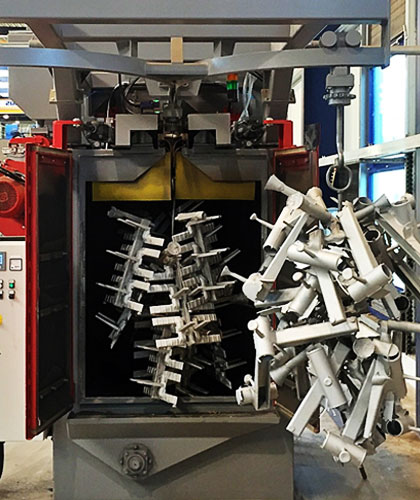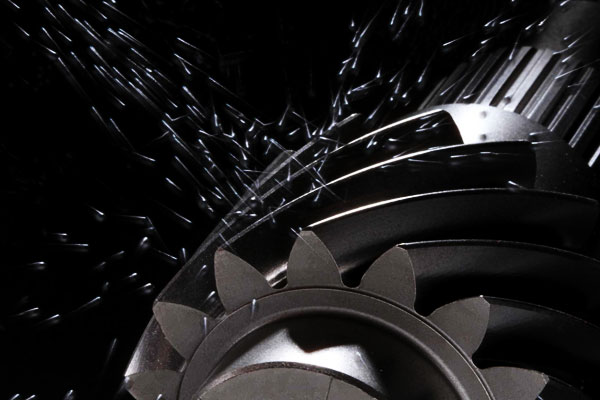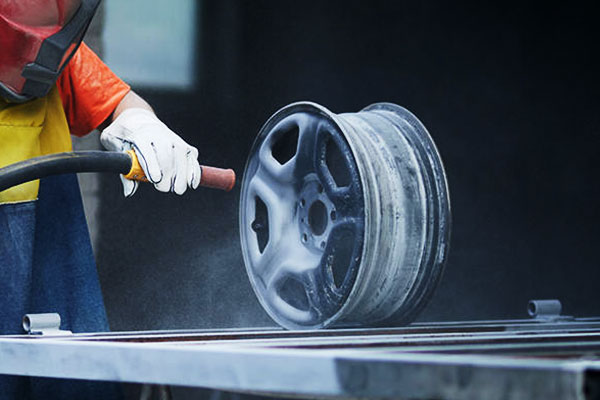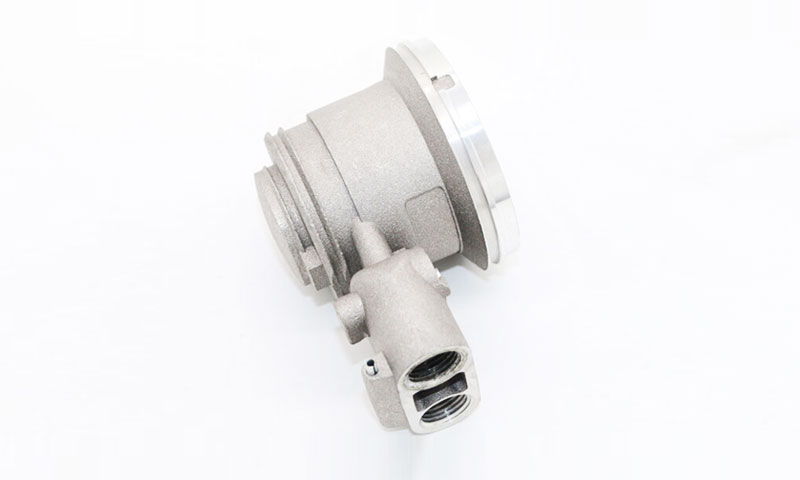1. መግቢያ
ተኩስ, ዶቃ ማፈንዳት, እና አሸዋ (abrasive) blasting are three common surface-preparation technologies.
They use different media and energy-transfer mechanisms, deliver distinct surface finishes and residual stress states, and therefore suit different engineering objectives:
high-throughput cleaning and peening (ተኩስ), cosmetic satin finishes or light peening (ዶቃ ማፈንዳት), and aggressive material/removal and anchor-profile generation for coatings (abrasive/sand blasting).
Below is a technical comparison you can rely on for specification, procurement and process selection.
2. What is Shot Blasting?
ተኩስ is a high-energy, mechanical surface-preparation process that propels metallic media (most commonly steel shot or steel grit) onto a workpiece to clean, መገለጫ, and mechanically treat the surface.
It combines efficient removal of scale, አሸዋ, weld spatter and coatings with a peening action that can introduce beneficial compressive residual stresses—making it both a cleaning and a functional treatment widely used in fabrication, foundry and fatigue-critical applications.

ቁልፍ ባህሪያት
- ሚዲያ: typically steel shot (spherical) or steel grit (ማዕዘን); media sizes commonly range from A60 to A320 (shot) and G12–G40 (grit).
- Drive principle: ሴንቲምጋል (wheel/turbine) acceleration — high throughput without compressed-air consumption.
- Primary effects: scale/remnant removal, surface decontamination, anchor-profile generation (መካከለኛ), and surface peening (የመዋቢያ ውጥረት).
- Economics: media is reusable for thousands of cycles, giving low media cost per m² on large jobs.
እንዴት እንደሚሰራ
A high-speed rotating impeller (wheel) throws shot radially at the part.
Each particle carries kinetic energy; upon impact that energy is transferred to the substrate, plastically deforming asperities, dislodging loosely bonded material and producing a controlled surface texture.
Repeated impacts across the surface produce an overall “peening” effect analogous to the simultaneous action of many tiny hammers.
Typical equipment, media and operating ranges
| ግቤት | የተለመደው ክልል / ምሳሌዎች | ማስታወሻዎች |
| የማሽን ዓይነት | Single/multi-wheel centrifugal blast machines, tumble/rotary blast systems, conveyor blast, robotic wheel blast cells | Selection depends on part size, ጂኦሜትሪ, እና ማስተላለፊያ |
| የሚዲያ ዓይነት | Steel shot (A-series, ለምሳሌ., A60–A320), Steel grit (G-sach, ለምሳሌ., G12–G40), Specialty stainless shot | Shot = spherical, grit = angular; stainless for non-ferrous parts |
| Media Diameter | 0.3-3 ሚሜ (typical A60–A320) | Affects surface profile and cleaning aggressiveness |
| Media Velocity | 20–70 m/s | Depends on wheel RPM and shot size; higher velocity = higher impact energy |
| Almen Intensity | 0.006–0.040 in-A | Used to quantify peening effect; measured with Almen strips |
| Surface Profile (Rz) | 10-50 μm | Medium anchor profile for coatings; controlled by media type, standoff, and exposure |
| ግፊት | Tens to thousands of kg/h | Multi-wheel systems allow very high throughput for mass production |
Surface results (what to expect)
- Cleaning efficacy: excellent for mill scale, ዝገት, አሸዋ, weld spatter and slag — leaves a clean, reactive metal surface suitable for coating.
- Surface texture: medium anchor profile suitable for many industrial coatings; profile controllable by media size/type and exposure.
- Residual stress state: near-surface የመደናገጫ ቀሪ ጭንቀቶች are introduced (beneficial for fatigue life and crack-growth resistance).
- Surface hardness: modest work-hardening of the subsurface layer—typical increases of ~5–30% depending on steel grade and intensity.
- Material removal: primarily plastic deformation; net substrate loss per pass is low compared with cutting abrasives, but cumulative removal can occur with heavy grit.
Typical industrial applications
- Structural steel preparation before protective coatings (ሳህኖች, ጨረሮች, girders).
- Foundry cleaning — removing sand, scale and parting lines from castings.
- Fatigue-critical components — controlled shot peening of springs, ማረፊያ ማርሽ, turbine components to improve fatigue life.
- Automotive and rail for mass production parts that require both cleaning and surface strengthening.
- Surface refurbishment where worn surfaces are peened and then finished/ground to dimension.
3. ዶቃ ፍንዳታ ምንድን ነው?
ዶቃ ማፈንዳት is a controlled abrasive-blasting process that uses spherical media (የመስታወት ዶቃዎች, ceramic beads, metal beads) to clean, ደቡር, satinize or lightly peen a surface.
Compared with wheel-type shot blasting and with angular abrasive (sand/grit) ማፈንዳት, bead blasting is less aggressive, produces a ለስላሳ, uniform satin finish, and imparts only light compressive stresses.
It’s widely used where appearance, tight dimensional control and gentle surface treatment are required.

Key features
- Media geometry: spherical beads roll and rebound on impact, so the process tends to ለስላሳ micro-asperities rather than aggressively cut material.
- ጨርስ: typical outcome is a satin/matte appearance with low-to-moderate surface texture—preferred for cosmetic parts and for preparing surfaces for plating without heavy anchor profiles.
- ቁጥጥር: easily targeted (pressure pot or blast cabinet) and well suited for small/complex parts and selective-area treatment.
- Low substrate loss: minimal material removal compared with angular abrasives—good for thin-walled or precision parts.
- Optional light peening: with metallic beads (steel beads) or at higher pressures bead blasting can impart a beneficial light peening effect.
How bead blasting works
Compressed air or a centrifugal wheel accelerates spherical beads toward the workpiece.
On impact the bead’s kinetic energy is dissipated largely through ማንከባለል, bouncing and plastic smoothing of surface peaks.
Because beads do not present sharp cutting edges, the dominant mechanism is surface deformation and abrasion rather than cutting, በዚህ ምክንያት:
- removal of soft contaminants or burrs,
- smoothing of sharp edges, እና
- a satinized, uniform finish without the deep anchor profile left by angular abrasives.
Typical equipment, media and practical parameter ranges
| ግቤት | የተለመደው ክልል / ምሳሌዎች ምሳሌዎች | ማስታወሻዎች |
| Media types | የመስታወት ዶቃዎች (soda-lime or borosilicate), ceramic beads, steel/stainless beads | Media choice controls finish, durability and any metallic residue |
| Media size | 50 µm – 1.0 ሚ.ሜ (0.05–1000 µm) የተለመደ; typical cosmetic sizes 100–400 µm | Smaller beads → finer finish; larger beads → stronger satin/peen |
| Acceleration method | Pressure-pot (air blast), suction blaster, wheel-type for metal beads, blast cabinet, robotic cells | Pressure pot most common for controlled lab/bench work |
| ኦፕሬቲንግ ግፊት | 2–6 bar (30–90 psi) typical for pressure blasting | Higher pressure increases intensity and can increase peening |
Media velocity (በግምት.) |
30–80 m/s (ማሽን & pressure dependent) | Lower than heavy wheel shot at equivalent mass in many cases |
| Typical profile (Rz / ራ) | ≤5–15 µm Rz (Ra values typically low, ለምሳሌ., ራ < 1.0–2.5 µm) | Very dependent on bead size, standoff and time |
| Almen intensity (if measured) | በጣም ዝቅተኛ: በተለምዶ <0.006 in-A; may reach ~0.01 in-A with large metal beads/high pressure | Use Almen only if peening is an objective |
| ግፊት | Moderate — cabinet/bench work or small- to medium-batch production | Lower than wheel shot on large parts; ideal for smaller series |
Surface results: ማጽዳት, መገለጫ, ቀሪ ውጥረት, ጥንካሬ
- ማጽዳት: removes light scale, surface oxides, buffing compounds, light rust, እና ብልጭታ.
Effective for degreasing/cleaning prior to plating or painting when deep profile is not wanted. - Surface profile / ሸካራነት: produces smooth satin finish with small anchor profile—suitable for decorative finishes and plating where low profile is required. Typical Rz ≤ 5–15 µm depending on bead size.
- ቀሪ ውጥረት: imparts light compressive stresses when metallic beads or higher pressures are used; the peening effect is modest compared with wheel shot peening.
For fatigue-critical components use Almen-strip verification if peening is required. - ጥንካሬ / ስጋት: minor near-surface work hardening—typically small hardness increases (~0–15%), highly dependent on base material and intensity.
- Material removal: ዝቅተኛ; good for precision components and thin sections where dimensional integrity is critical.
Typical industrial applications of bead blasting
- Cosmetic finishing for consumer hardware, አውቶሞቲቭ ትራም, jewelry and architectural fittings (uniform satin appearance).
- Pre-plating / pre-coating cleaning when a small profile is desired for adhesion but heavy cutting is undesirable.
- Deburring and edge radiusing of machined parts and castings where sharp edges must be smoothed without losing material.
- ሕክምና እና የኤሮስፔስ አካላት where surface finish, cleanliness and dimensional control are critical (የሕክምና መሳሪያዎች, orthopaedic implants—note material compatibility and cleanliness process controls).
- Mold and tooling maintenance, to remove flash without changing critical dimensions.
- Restoration and conservation work, where a gentle finish is required on delicate parts.
4. What is Sand Blasting? (መራራ / ጋሪንግ)
Sand blasting (more correctly called አስጸያፊ ፍንዳታ ወይም grit blasting) is a pneumatic surface-preparation process that uses ማዕዘን, cutting abrasives accelerated by compressed air to remove ሽፋኖች, rust and scale and to create a controlled anchor profile for subsequent coatings.
Although the lay term “sandblasting” persists, modern industrial practice avoids crystalline silica (ሩብዛዝ) and uses engineered abrasives (garnet, aluminium oxide, Slab, ወዘተ.) because of health and regulatory concerns.

Key features
- Primary action: cutting/erosion — angular abrasive particles fracture and strip material from the surface rather than deforming it.
- Designed outcome: rapid removal of paint, heavy corrosion, mill scale and creation of a repeatable anchor profile (specified in µm or mils) that ensures coating adhesion.
- Consumable media: abrasives are typically single-use or limited-recycle (cost driven by consumption).
- ተለዋዋጭነት: nozzle-focused jets allow access to complex geometries, corners and welds; suitable for shop and field work with proper containment.
How Sand / Abrasive Blasting Works (ሜካኒኮች)
Compressed air (or sometimes a venturi/pressure pot system) accelerates abrasive grains through a nozzle.
On impact the angular grain bites into the substrate, fracturing surface contaminants and micro-breaking the substrate surface to leave an anchor pattern.
The profile depth and shape depend on abrasive hardness/size/shape, air pressure, nozzle diameter, standoff distance and traverse speed.
Typical equipment, media and practical parameter ranges
| ግቤት | የተለመዱ ምሳሌዎች / ውድድሮች | ማስታወሻዎች |
| Common media | Garnet (almandine) 80–120 mesh, Aluminium oxide (አል ₃) 80–240 grit, Steel grit, Copper slag, የመስታወት ዶቃዎች (for low-profile work) | Garnet is widely used (good cutting, low dust); avoid silica/quartz sand |
| Abrasive size / mesh | 80–240 mesh (garnet typical 80–120 mesh for coarse profile; 120–240 for finer) | Lower mesh = larger particle = coarser profile |
| Acceleration method | Pressure pot / pressure blasting, suction/blast pots, automated nozzle robots | Pressure pot is standard for industrial work |
| Air pressure | 0.4–7 bar (6–100 psi); typical industrial jobs use 4–7 bar (60–100 psi) | Higher pressure → higher velocity and cutting rate |
Particle velocity (በግምት.) |
50–100 m/s in focused jets (depends on nozzle & ግፊት) | Velocity and particle mass determine erosion rate |
| Typical anchor profile (Rz) | 20–200 µm Rz (common protective coatings: 25–75 µm) | Specify profile range required by coating supplier |
| ግፊት / removal rate | Moderate to high — depends on media size, pressure and operator skill | Consumable cost significant; garnet consumption often 1–5 kg/m² for moderate removal |
| Containment / extraction | Enclosed blast rooms, portable containment with dust collectors and HEPA filters | Essential to control respirable dust and waste |
Surface results: ማጽዳት, መገለጫ, ቀሪ ውጥረት, ጥንካሬ
- ማጽዳት: highly effective at removing thick paint, ዝገት, ወገኖች ልኬት, marine growth and old coatings.
- Profile (anchor pattern): produces a defined anchor profile required by most industrial paint systems; typical specification ranges are 25–75 µm Rz for conventional high-performance coatings.
- ቀሪ ውጥረት: predominantly cutting action — no beneficial compressive peening; in some aggressive or overheating conditions minor tensile micro-stresses or embedded abrasive particles can occur.
- ጥንካሬ: the substrate metallurgical hardness is largely unchanged (no work hardening as in shot peening) except for tiny local deformation; abrasive blasting does አይደለም substitute for peening where fatigue improvement is required.
- Material removal: significant compared with bead/shot processes — allowances for dimensional loss must be included in tolerancing.
Typical industrial applications
- Surface preparation for protective coatings (የባህር ዳርቻ, ድልድይ, የቧንቧ መስመር, tank interiors).
- Removal of thick or multiple paint layers, ሽፋኖች, adhesives.
- Preparation for thermal spray, rubber lining or heavy industrial paint systems.
- Cleaning and refurbishment of corroded structural members, የመርከብ ጉዞ, እና የኢንዱስትሪ መሳሪያዎች.
- Pre-weld cleaning in repair shops and fabrication yards (with appropriate containment).
5. Comprehensive Comparison: ተኩስ vs bes besslings blassningsningshing
Below is an engineering-focused comparison you can use to choose a blasting method, write specifications, or brief suppliers.
| ባህሪ | የተኩስ ፍንዳታ (wheel/turbine) | ዶቃ ማፈንዳት (glass/ceramic/metal beads) | አሸዋ / የአላሽ ብልጭታ (garnet, አል ₃, ሲሲ, ወዘተ.) |
| Primary media | Steel shot (spherical) / steel grit (ማዕዘን) | የመስታወት ዶቃዎች, ceramic beads, stainless/steel beads (spherical) | Angular abrasives: garnet, አሉሚኒየም ኦክሳይድ, ሲሊከን ካርበይድ, Slab |
| ሜካኒዝም | High-energy impact → plastic deformation & ማጠፊያ | ተጽዕኖ + rolling → smoothing / light peening | መቁረጥ / erosion → material removal & profile generation |
| Typical acceleration | Centrifugal wheel (no external air) | Pressure pot (አየር) or wheel | Pressure pot (air blast) |
| Typical pressure / drive | - - (wheel RPM) | 2–6 bar (30–90 psi) | 0.4–7 bar (6–100 psi) (የኢንዱስትሪ: 4–7 bar common) |
| Typical particle velocity | 20–70 m/s | 30–80 m/s | 50–100 m/s |
| Common media sizes | Shot Ø ≈ 0.3–3 mm (A60–A320); grit G12–G40 | 50 µm – 1.0 ሚ.ሜ (typical 100–400 µm) | 80–240 mesh (garnet common 80–120 mesh) |
| Surface profile (typical Rz) | 10-50 μm (መካከለኛ) | ≤ 5–15 µm (ጥሩ / ሳቲን) | 20-200 μm (controlled anchor profile) |
| ቀሪ ውጥረት / ማጠፊያ | Strong compressive (beneficial for fatigue) — Almen 0.006–0.040 in-A ዓይነተኛ | Light compressive; በተለምዶ <0.006 in-A unless heavy beads/pressure used | የለም (cutting action) — no peening benefit |
Material removal |
ዝቅተኛ (mainly plastic deformation) | በጣም ዝቅተኛ (smoothing, ማረም) | ከፍተኛ (erosive removal) |
| Media reuse & ወጪ | Reusable thousands of cycles — low ongoing media cost | Reusable until fractured—moderate cost | Consumable — ongoing media consumption; higher operating cost |
| ግፊት / ምርታማነት | በጣም ከፍተኛ (continuous production lines) | መጠነኛ (cabinet/bench or medium batches) | መጠነኛ; manual nozzle work is labor-intensive |
| የተለመዱ ትግበራዎች | Structural steel, ስርዓቶች, mass cleaning, ማጠፊያ | Cosmetic finishing, ማረም, medical/precision parts, satinizing | Heavy coating removal, anchor profile prep for protective coatings |
| Health & environmental risk | Dust/noise — contained systems mitigate | Dust/noise — lower cutting dust, still needs capture | High dust hazard (avoid silica); strict containment & filtration required |
| When NOT to use | When fine cosmetic finish or tight dimensional tolerances are required | When aggressive coating removal / deep anchor profile is required | When peening or fatigue improvement is required; avoid on thin/precision parts unless tightly controlled |
Typical procurement language
- ተኩስ (production structural):
Perform wheel-type shot blasting to achieve near-white metal cleanliness (አይኤስኦ 8501-1 Sa 2.5) and an anchor profile of 30–70 µm Rz. Use A120 steel shot; deliver media analysis and one witness coupon per shift.
For fatigue-sensitive surfaces, perform peening to Almen intensity 0.012–0.018 in-A with full coverage and provide Almen strip records. - ዶቃ ማፈንዳት (cosmetic):
Bead blast all exposed faces using soda-lime glass beads (0.15-0.4 ሚሜ) በ 3–5 bar to achieve a uniform satin finish; maximum Ra ≤ 1.0 µm, Rz ≤ 10 µm.
No dimensional change >0.05 mm allowed. Provide photographic sample and media replacement log. - አስጸያፊ ፍንዳታ (coating prep):
Dry abrasive blast to አይኤስኦ 8501-1 Sa 2.5 (near-white metal) using garnet 80–120 mesh at 4–6 bar to obtain an anchor profile 40–75 µm Rz (replica tape verification).
Contain dust, use HEPA filtration, and collect spent abrasive for disposal per local regulations.
6. ማጠቃለያ
ተኩስ, bead blasting and sand (abrasive) blasting are complementary tools in surface engineering.
The right choice depends on the objective: peening and large-area cleaning (shot), cosmetic smoothing and light cleaning (bead), or aggressive removal and coating preparation (abrasive).
የሚጠየቁ ጥያቄዎች
Which process is best for coating adhesion?
Sand blasting (R 6.3-25 μm) creates the deepest profile, ideal for heavy-duty coatings (marine paint, industrial enamel).
For lighter coatings (powder coat), ተኩስ (RA 3.2-12.5 μm) በቂ ነው.
Is bead blasting safe for aluminum components?
Yes—glass/ceramic beads are soft and spherical, avoiding deformation of thin aluminum parts.
Use 0.2–0.4 MPa pressure and 100–300 μm media for optimal results.
Can shot blasting replace sand blasting for marine applications?
Yes—steel shot blasting achieves SSPC-SP 10 ማጽዳት (equivalent to sand blasting) with higher efficiency, but media costs are 2–3x higher.
Sand blasting remains cost-effective for large marine structures.
Does bead blasting affect the mechanical properties of metal?
No—bead blasting’s low impact leaves residual stress <±50 MPa and no measurable change to hardness or tensile strength, preserving original material properties.
How do I measure surface profile?
ተጠቀም ሀ stylus profilometer, optical profilometer or replica tape (replica method) and report Ra/Rz or peak-to-valley values; many coating specs call out profile range in µm or mils.
What PPE and controls are required?
Use blast helmets with supplied air, hearing protection, protective clothing, and sealed enclosures with HEPA dust collectors or wet capture for outdoor work.
Follow local regulations for respirable dust and waste disposal.



